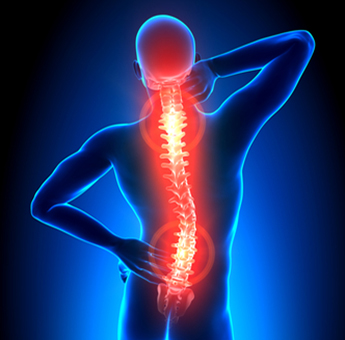Posterior Lumbar Interbody Fusion (PLIF): fusion procedure where spine is accessed through patient’s back.

Posterolateral Lumbar Fusion is a surgical procedure used to treat problems with spinal instability. It fuses together the painful vertebrae so that they heal into a single solid bone. There are many methods of obtaining spinal fusion, but the most commonly used is Posterolateral Lumbar Fusion. This type of spinal fusion involves placing bone graft between the transverse processes of the affected vertebrae.
Who needs Posterolateral Lumbar Fusion?
Patients who have spondilolisthesis are most common candidates of Posterolateral Lumbar Fusion. Spondilolisthesis is the condition in which the vertebra slips forward and pinches a nerve. This happens due to weakened joints or fractured bones. The pinched nerve causes pain, which radiates to the legs and feet.
This procedure may also be suggested for conditions such as disc herniation, curvature of the spinal column, scoliosis, or for an injury or fracture of the spinal cord.
What are the steps involved in Posterolateral Lumbar Fusion?
Incision
The surgeon makes a small incision along the midline of the lower back. Muscles surrounding the spine are pulled back to expose the vertebrae.
Removal of lamina
The surgeon then removes the lamina, which is the bone that covers the spinal cord. Removal of lamina relieves the pressure on the nerve roots and alleviates pain.
Removal of herniated disc and fragments
Next, the surgeon clears away any herniated disc, fragments, or bones that may be pinching the root nerves.
Bone graft
Bone graft is added to the sides of the spine. The bone grafts will fuse to the spinal cord and form a solid bone bridge.
Insertion of screws and rods
The surgeon then adds screws and rods. Screws help to secure the rods that hold the spinal cord, discs and vertebrae in place while the graft heals. Over time, the bone graft will fuse with the spine and keep the discs from slipping.
Closure
The procedure ends when the surgeon moves the muscles back to their correct place and closes the wound. The incision is closed with the help of stitches. A medical bandage is applied after cleaning the wound.
What happens after Posterolateral Lumbar Fusion?
After this operation, the patient may be asked to wear a plastic brace for a few weeks. The patient should note that healing a fusion can take many months to complete. It is important to be patient after the procedure, as improvements in symptoms will be slow.
Posterior lumbar interbody fusion
Overview of treatment
Posterior lumbar interbody fusion, or PLIF, is intended to relieve back and leg pain by removing a damaged lumbar disc and fusing the two adjacent vertebrae together using bone graft material. The approach for this procedure is from the patient’s back, or posterior.
Who needs this treatment?
Your doctor may determine you are a candidate for Posterior Lumbar Interbody Fusion if you have a history of mechanical low back pain. This low back pain may or may be accompanied by leg pain. Other factors may include degenerative disc disease and lumbar instability, Spondylolisthesis, Spinal Stenosis, spinal instability caused by previous surgeries, or pseudoarthritis. Additional factors include general health, age, activity levels and other life factors.
How is a posterior lumbar interbody fusion performed?
| The patient is placed facedown on the surgical table. A three to six inch incision is made in traditional openings, or a minimally invasive approach may be made using very small incisions and a tubular retractor to gain access to the damaged disc. | |
| To gain access to the damaged disc, all or a portion of the lamina is removed. This exposes the disc for access and removal. | |
| The damaged disc nucleus and annulus is removed, but the disc wall is left mostly intact to help contain the bone graft material. | |
| Bone grafts and/or allograft material (morselized bone) is placed inside the disc space. The bone grafts help restore disc height and relieve pressure on nerves causing pain. | |
| To maintain stability and hold the graft in position, the surgeon may add rods, screws or other surgical constructs, for additional support. Additional bone graft may be added along the sides of the spine. | |
| The allograft material helps your body grow bone around the implants and creates a natural bony bridge that connects the two vertebrae. This solid bridge of bone is called a fusion. |
After treatment and recovery
Your surgeon may place a drainage tube in the wound site. He may also elect to use a back brace to stabilize your spine while it heals. You may be in the hospital three to five days with a standard incision. Minimally invasive approaches typically result in a shorter hospital stay of one to two days.
You may be prescribed medication and physical therapy after sufficient time has passed for the bone graft to occur. Be sure to follow your physician’s treatment and recovery plan, and always consult them if you have any questions.
Patient information
As with any surgical procedure, there are risks. The Posterior Lumbar Interbody Fusion procedure may have, but are not limited to, the following risks:
-
Anesthetic reactions
-
Blood clots
-
Infection
-
Nerve Damage
-
Hardware or Graft failure or problems
-
Nonunion
-
Ongoing pain
Always discuss surgical procedures with your doctor to ensure you understand the risks and benefits of this procedure.
This material is intended to give the patient an overview of surgical procedures and treatments and is not intended to replace the advice and guidance of a physician. Always consult your doctor for any questions.
